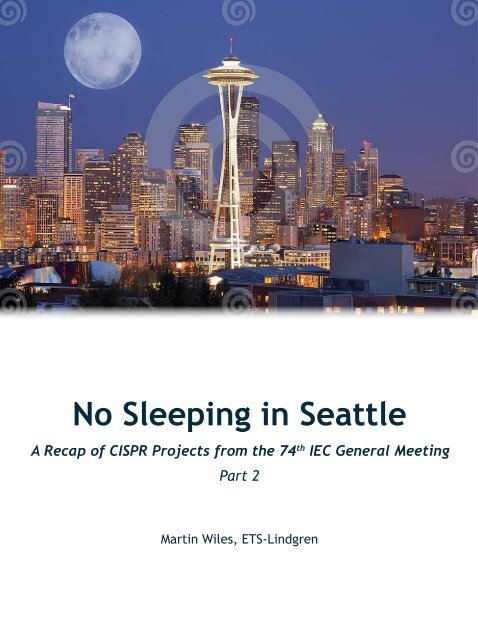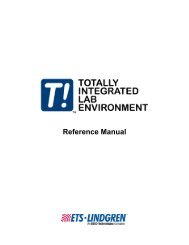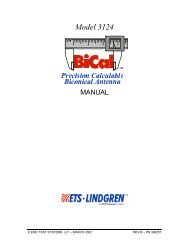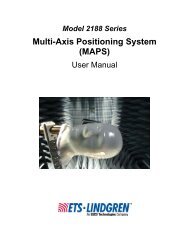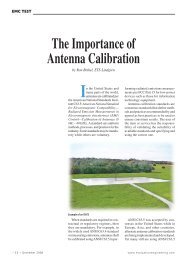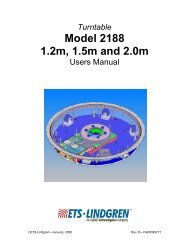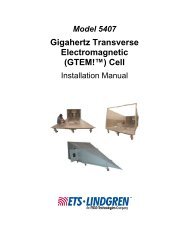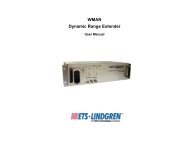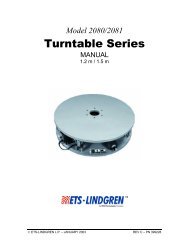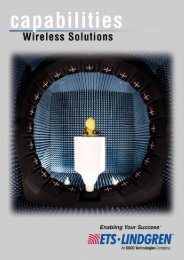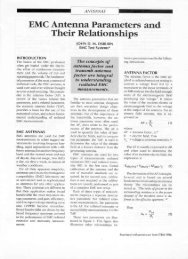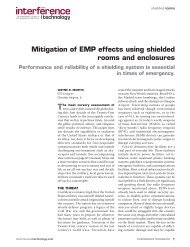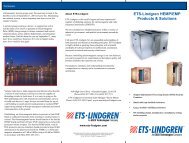No Sleeping in Seattle (Part 2) - ETS-Lindgren
No Sleeping in Seattle (Part 2) - ETS-Lindgren
No Sleeping in Seattle (Part 2) - ETS-Lindgren
You also want an ePaper? Increase the reach of your titles
YUMPU automatically turns print PDFs into web optimized ePapers that Google loves.
<strong>No</strong> <strong>Sleep<strong>in</strong>g</strong> <strong>in</strong> <strong>Seattle</strong><br />
A Recap of CISPR Projects from the 74 th IEC General Meet<strong>in</strong>g<br />
<strong>Part</strong> 2<br />
Mart<strong>in</strong> Wiles, <strong>ETS</strong>-L<strong>in</strong>dgren
In this second <strong>in</strong>stallment of a two part article, we<br />
cont<strong>in</strong>ue our review of the recent meet<strong>in</strong>g of IEC-<br />
CISPR held <strong>in</strong> October 2010 <strong>in</strong> <strong>Seattle</strong>. In the first part of<br />
this article, we have described the current changes affect<strong>in</strong>g<br />
the basic standard CISPR 16 and the activities of its experts<br />
with<strong>in</strong> CISPR sub-committee (SC) A. We now take a look at<br />
the activities of the other CISPR sub-committees responsible<br />
for prepar<strong>in</strong>g the CISPR product standards. We also describe<br />
some of the projects shared by CISPR and IEC TC 77B<br />
(High Frequency Phenomena).<br />
PRODUCT STANDARDS<br />
CISPR SC B<br />
Industrial, scientific and medical (ISM) standards<br />
This sub-committee is responsible for the follow<strong>in</strong>g standard:<br />
y CISPR 11 - Industrial, scientific and medical (ISM)<br />
radio-frequency equipment - Electromagnetic disturbance<br />
characteristics - Limits and methods of measurement,<br />
2009<br />
Work<strong>in</strong>g Groups<br />
■■ WG 1 - Industrial, scientific and medical (ISM) radio<br />
frequency apparatus<br />
Amendment 1 to CISPR 11 Ed. 5: Selection criteria for<br />
the m<strong>in</strong>imum separation distance between EUT and<br />
measurement antenna<br />
■■ Proposal to replace the “Class” criterion currently<br />
used <strong>in</strong> CISPR 11 by a “size-of equipment” criterion.<br />
A measur<strong>in</strong>g distance less than 10 m is allowed for<br />
“small equipment” either positioned on a table top or<br />
stand<strong>in</strong>g on the floor which, <strong>in</strong>clud<strong>in</strong>g its cables, fits <strong>in</strong>to<br />
a cyl<strong>in</strong>drical test volume of 1.2 m <strong>in</strong> diameter and 1.5 m<br />
above the ground plane.<br />
Status: F<strong>in</strong>al Draft International Standard (FDIS)<br />
■■ WG 2 - Interference from overhead power l<strong>in</strong>es, highvoltage<br />
equipment and electric traction<br />
Status: The future CISPR 11, Ed 5.0 is currently under<br />
revision with key issues related to harmoniz<strong>in</strong>g methods<br />
with CISPR 16.<br />
CISPR SC D<br />
Electromagnetic disturbances related to electric/electronic<br />
equipment on vehicles and <strong>in</strong>ternal combustion eng<strong>in</strong>e<br />
powered devices<br />
This sub-committee is responsible for the follow<strong>in</strong>g<br />
standards:<br />
<strong>No</strong> <strong>Sleep<strong>in</strong>g</strong> <strong>in</strong> <strong>Seattle</strong> FEATURE<br />
y CISPR 12 Vehicles, boats, and <strong>in</strong>ternal combustion<br />
eng<strong>in</strong>es - Radio disturbance characteristics - Limits and<br />
methods of measurement for the protection of off-board<br />
receivers, 2009<br />
y CISPR 25 Vehicles, boats, and <strong>in</strong>ternal combustion<br />
eng<strong>in</strong>es - Radio disturbance characteristics - Limits and<br />
methods of measurement for the protection of on-board<br />
receivers, 2008<br />
Work<strong>in</strong>g Groups<br />
■■ WG 1 - Protection of receivers used <strong>in</strong> build<strong>in</strong>gs, along<br />
the roadside, or <strong>in</strong> outdoor areas<br />
{ { CISPR 12 Ed 6.1 2009-03<br />
{ { Status: First Committee Draft (CD) Ed 7.0 under<br />
discussion <strong>in</strong> CISPR D<br />
■■ WG 2 - Protection of on-board and adjacent vehicle<br />
receivers<br />
{ { CISPR 25 Ed 3.0 2008-03<br />
{ { Status: Ed 4.0 First CD 2010-11; CDV 2012-03; FDIS<br />
2012 -11; Publication 2013-02<br />
The third edition of CISPR 25 Ed 3.0 announced<br />
several items for future work <strong>in</strong> annex I.<br />
Some items will be handled with<strong>in</strong> the overall revision<br />
work of CISPR 25.<br />
The chamber validation methods (ALSE) used for the<br />
tests def<strong>in</strong>ed <strong>in</strong> CISPR 25 are a more complex issue,<br />
which is be<strong>in</strong>g addressed separately with the expertise<br />
of CISPR/A. The work on the fourth edition is therefore<br />
split up <strong>in</strong>to two tasks with separate CDs. Depend<strong>in</strong>g on<br />
the comments received from the National Committees,<br />
the documents will be merged <strong>in</strong> the enquiry or<br />
approval stage.<br />
An automotive EMC chamber for<br />
whole vehicle test<strong>in</strong>g per CISPR 25.<br />
April 2011 IN Compliance 39<br />
Image courtesy of <strong>ETS</strong>-L<strong>in</strong>dgren
FEATURE <strong>No</strong> <strong>Sleep<strong>in</strong>g</strong> <strong>in</strong> <strong>Seattle</strong><br />
CISPR SC A – CISPR SC D Jo<strong>in</strong>t Task Force (JTF)<br />
Development of appropriate Fast Fourier Transform (FFT)<br />
methodology<br />
■■ Jo<strong>in</strong>t Task Force between CISPR/A and CISPR/D - FFTbased<br />
emission measurement apparatus - Specification<br />
and application<br />
Status: The work is essentially complete.<br />
For details see CISPR A discussion <strong>in</strong> <strong>Part</strong> 1 of this article<br />
(IN Compliance Magaz<strong>in</strong>e, February 2011).<br />
CISPR SC D – CISPR SC A JTF<br />
Development of a chamber validation method for CISPR 25<br />
This Jo<strong>in</strong>t Task Force of CISPR D and CISPR A experts<br />
was assembled to develop a procedure for the validation of<br />
chambers used for radiated emission measurements made<br />
accord<strong>in</strong>g to CISPR 25.<br />
■■ The chamber validation procedure developed by the<br />
JTF would then be presented to CISPR/D as a proposed<br />
Annex for CISPR 25 4th Edition.<br />
■■ As a secondary agenda, this JTF would also handle other<br />
chamber and site validation proposals for other CISPR/D<br />
specifications such as CISPR 12.<br />
■■ The aim of this work is to<br />
{ { Increase the reproducibility of measurements <strong>in</strong> such<br />
anechoic chambers,<br />
{ { Be applicable <strong>in</strong> the frequency range between 150 kHz<br />
to 2500 MHz,<br />
{ { Include the ground plane bench,<br />
{ { Make use of the measurement antennas and their<br />
positions dur<strong>in</strong>g CISPR 25 measurements,<br />
{ { Be able to reference to established calibration<br />
environments (e.g. TEM cell, OATS),<br />
{ { To specify measurement uncerta<strong>in</strong>ty for the site,<br />
{ { Detect improper connection of the table to the floor or<br />
the wall of the ALSE, and,<br />
{ { Give guidance on the m<strong>in</strong>imum distances between the<br />
EUT and its wir<strong>in</strong>g harness, and the chamber absorber<br />
material<br />
The JTF has looked at currently used chamber validation<br />
procedures by the <strong>in</strong>dustry and also some custom procedures<br />
which have been developed for validation of chambers used<br />
for 1 meter radiated emissions measurements.<br />
As a result, two chamber validation procedures have shown<br />
potential and could provide the CISPR 25 specification users<br />
some flexibility. It was thus decided that the proposed annex<br />
would conta<strong>in</strong> two chamber validation procedures and the<br />
chamber performance can be determ<strong>in</strong>ed by the use of either<br />
method (both methods are not required). The characterisation<br />
procedures are as follows:<br />
1. Reference Site Measurement Method:<br />
150 kHz - 1 GHz<br />
This method uses an OATS or Alternate OATS<br />
as a reference site. The measurements are made<br />
similar to <strong>No</strong>rmalized Site Attenuation (NSA)<br />
measurements. The reference site measurements<br />
are then repeated <strong>in</strong> the shielded enclosure. The<br />
reference site measurements are then compared to<br />
the shielded enclosure measurements <strong>in</strong> order to<br />
determ<strong>in</strong>e if the shielded enclosure measurements<br />
are with<strong>in</strong> a reasonable tolerance.<br />
2. Modelled Long Wire Antenna Method:<br />
150 kHz - 1 GHz<br />
This method uses a 50 cm “long wire” antenna as<br />
the transmitt<strong>in</strong>g antenna. This long-wire antenna is<br />
then modelled with a ground plane of a standard size<br />
(2.5 m x 1 m). Measurements are then made on the<br />
long-wire antenna <strong>in</strong> the shielded enclosure. The<br />
shielded enclosure measurements are then compared<br />
to the modelled fields <strong>in</strong> order to determ<strong>in</strong>e if the<br />
shielded enclosure measurements are with<strong>in</strong> a<br />
reasonable tolerance.<br />
NOTE: The “reasonable tolerance” has been<br />
proposed as:<br />
The ALSE and its <strong>in</strong>stallation (physical layout,<br />
ground plane size, ground plane ground<strong>in</strong>g, RF<br />
absorber, etc.) is suitable for test<strong>in</strong>g, if the ∆ =<br />
Reference – Enclosure is with<strong>in</strong> ± 6 dB for ≥ 90% of<br />
the data po<strong>in</strong>ts across the entire frequency range of<br />
150 kHz to 1 GHz.<br />
Other Future Work<br />
■■ Correlation to Japanese JASO –D002 standards: Experts<br />
from Japan have proposed a procedure to validate<br />
chambers used for radiated emissions measurements on<br />
vehicles. This is a proposed Annex for CISPR 12. S<strong>in</strong>ce<br />
this is a secondary project for this JTF, CISPR/D/WG<br />
1 may decide to have this JTF work on this chamber<br />
validation procedure for them.<br />
■■ Methods > 1 GHz<br />
■■ Vehicle test chamber<br />
Status: CD out for comment <strong>No</strong>vember 2010<br />
40 IN Compliance April 2011 www.<strong>in</strong>compliancemag.com
CISPR SC F<br />
Household Appliances, electric tools and similar apparatus<br />
This sub-committee is responsible for the follow<strong>in</strong>g<br />
standards:<br />
y CISPR 14-1 Electromagnetic compatibility - Requirements<br />
for household appliances, electric tools and similar<br />
apparatus - <strong>Part</strong> 1: Emission.200<br />
y CISPR 14-2 Electromagnetic compatibility - Requirements<br />
for household appliances, electric tools and similar<br />
apparatus - <strong>Part</strong> 2: Immunity - Product family standard.20<br />
y CISPR 15 Light<strong>in</strong>g – SC F work<strong>in</strong>g with SC A on use of<br />
CDN (coupl<strong>in</strong>g-decoupl<strong>in</strong>g networks).<br />
Work<strong>in</strong>g Groups<br />
■■ WG 1 - Household appliances <strong>in</strong>corporat<strong>in</strong>g electric<br />
motors and contact devices<br />
■■ WG 2 - Light<strong>in</strong>g equipment<br />
Other Jo<strong>in</strong>t Task Force<br />
■■ CISPR/CIS/A/JTF JTFA/F - Jo<strong>in</strong>t Task Force between<br />
CISPR/A AND CISPR/F – CDN measurement method of<br />
radio frequency disturbances for light<strong>in</strong>g equipment <strong>in</strong> the<br />
frequency range 30 MHz to 300 MHz<br />
Status: CD <strong>in</strong> preparation<br />
CISPR SC H<br />
Limits for the protection of radio services<br />
This sub-committee is responsible for the follow<strong>in</strong>g<br />
standards:<br />
y IEC 61000-6-1 (2005-03) Ed. 2.0 Generic standards<br />
Immunity for residential, commercial and light-<strong>in</strong>dustrial<br />
environments.<br />
{ { Status Ma<strong>in</strong>tenance Result Date: 2011<br />
y IEC 61000-6-2 (2005-01) Ed. 2.0 Generic standards<br />
Immunity for <strong>in</strong>dustrial environments.<br />
{ { Status Ma<strong>in</strong>tenance Result Date: 2011<br />
y IEC 61000-6-3 (2006-07) Ed. 2.0 Generic standards<br />
Emission for residential, commercial and light-<strong>in</strong>dustrial<br />
environments<br />
{ { Status Ma<strong>in</strong>tenance Result Date: 2010<br />
y IEC 61000-6-4 (2006-07) Ed. 2.0 Generic standards<br />
Emission for <strong>in</strong>dustrial environments<br />
{ { Status Ma<strong>in</strong>tenance Result Date: 2010<br />
<strong>No</strong> <strong>Sleep<strong>in</strong>g</strong> <strong>in</strong> <strong>Seattle</strong> FEATURE<br />
Work<strong>in</strong>g Group<br />
■■ WG 1<br />
Status: Both generic emission standards are <strong>in</strong> the FDIS<br />
stage and will <strong>in</strong>clude emissions from 1 to 6 GHz similar<br />
to CISPR 22 but with a difference <strong>in</strong> the class A and B<br />
def<strong>in</strong>itions. They will also <strong>in</strong>clude amendments for the use<br />
of FARs for floor stand<strong>in</strong>g equipment.<br />
CISPR SC I<br />
Information technology, multimedia, and receiver products<br />
This sub-committee is responsible for the follow<strong>in</strong>g<br />
standards:<br />
y CISPR 13<br />
{ { “Sound and television broadcast receivers<br />
and associated equipment - Radio disturbance<br />
characteristics - Limits and methods of measurement”,<br />
2009<br />
y CISPR 20<br />
{<br />
{ Sound and television broadcast receivers and<br />
associated equipment - Immunity characteristics -<br />
Limits and methods of measurement, 2006<br />
April 2011 IN Compliance 41
FEATURE <strong>No</strong> <strong>Sleep<strong>in</strong>g</strong> <strong>in</strong> <strong>Seattle</strong><br />
y CISPR 22<br />
{ { “Information technology equipment – Radio<br />
disturbance characteristics- limits and methods of<br />
measurement”, 2008<br />
y CISPR 24<br />
{ { Information technology equipment - Immunity<br />
characteristics - Limits and methods of measurement,<br />
2010<br />
y Draft CISPR 32<br />
{ { CISPR I/333/CDV Electromagnetic Compatibility<br />
(EMC) – Multimedia Equipment – Radio disturbance -<br />
characteristics - Limits and methods of measurements,<br />
2012<br />
y Draft CISPR 35<br />
{ { CISPR I/330/NP Electromagnetic Compatibility<br />
(EMC) – Multimedia Equipment – Radio disturbance -<br />
characteristics - Limits and methods of measurement,<br />
2013<br />
Work<strong>in</strong>g Groups<br />
■■ WG 1 - Methods of measurement and limits for<br />
radiation and immunity of broadcast receivers and<br />
associated equipment<br />
{ { Ma<strong>in</strong>tenance of CISPR 13 and 20<br />
{ { Current activity <strong>in</strong>cludes discussions on emissions<br />
from plasma TVs below 30 MHz and LTE <strong>in</strong>terference<br />
<strong>in</strong> Europe. When this activity matures, it will be passed<br />
on to WG 4 for <strong>in</strong>clusion <strong>in</strong> CISPR 35.<br />
Status: Stability period 2012<br />
EMC test<strong>in</strong>g of commercial products,<br />
such as televisions, per CISPR 22.<br />
Image courtesy of <strong>ETS</strong>-L<strong>in</strong>dgren<br />
■■ WG 2 - Methods of measurements and limits for<br />
emissions from multimedia equipment<br />
{ { CISPR 32 will comb<strong>in</strong>e and replace CISPR 13 and 22<br />
{ { S<strong>in</strong>ce TEM Cells, Reverberation Chambers and Fully<br />
Anechoic Rooms were removed from the ma<strong>in</strong> body<br />
of the draft CISPR 32 Ed1.0, a number of separate<br />
CDs have been prepared that take them <strong>in</strong>to account.<br />
They will be <strong>in</strong>tegrated <strong>in</strong>to the ma<strong>in</strong> body if they are<br />
successful. These <strong>in</strong>clude:<br />
{Proposed amendment of CISPR 32 outdoor units of<br />
home satellite receivers’ requirements.<br />
Status: CISPR/I/347/CD for comment<br />
{Proposed amendment of CISPR 32 to <strong>in</strong>cluded<br />
an <strong>in</strong>formative annex on Gigahertz TEM and<br />
reverberation chamber emission test methods and<br />
limits<br />
Status: CISPR/I/346/CD for comment<br />
{Proposed amendment of CISPR 32 Emission-test<br />
arrangement requirements for various types of<br />
multimedia equipment<br />
Status: CISPR/I/348/CD for comment<br />
{Proposed amendment of CISPR 32 to <strong>in</strong>clude the<br />
FAR emission test methods and limits<br />
Status: CISPR/I/345/CD for comment<br />
{Proposed amendment of CISPR 32 to specify which<br />
detectors should be used<br />
Status: CISPR/I/349/CD for comment<br />
■■ WG 3 - Methods of measurements and limits for<br />
radiation and immunity of Information Technology<br />
Equipment (Ma<strong>in</strong>tenance of CISPR 22 and 24)<br />
{ { CISPR 22 Ed 6.0<br />
{ { This standard is still with<strong>in</strong> its stabilization period<br />
and not due for “ma<strong>in</strong>tenance” until 2012, but a few<br />
clarifications have been noted recently as below :<br />
{Selection of average detector: CISPR 22 def<strong>in</strong>es<br />
limits for radiated emissions at frequencies between<br />
1 GHz and 6 GHz with respect to both average and<br />
peak detectors. CISPR 16-1-1 def<strong>in</strong>es two types of<br />
Average detector for use above 1 GHz. For the limits<br />
given <strong>in</strong> CISPR 22, the appropriate average detector<br />
is the l<strong>in</strong>ear average detector def<strong>in</strong>ed <strong>in</strong> CISPR 16-1-<br />
1 Edition 2.2, clause 6.4.1.<br />
{ { CISPR 24 Ed 2.0<br />
{ { This new edition was published <strong>in</strong> August, 2010<br />
■■ WG 4 - Methods of measurement and limits for<br />
immunity of multimedia equipment<br />
{ { (CISPR 35 Ed 1.0)<br />
42 IN Compliance April 2011 www.<strong>in</strong>compliancemag.com
{This will comb<strong>in</strong>e and replace CISPR 20 and 24<br />
Status: Third CD <strong>in</strong> preparation.<br />
Project Team: CISPR-22-PLT<br />
Amendment 1 to CISPR 22 Ed.6.0: Addition of limits<br />
and methods of measurement for conformance test<strong>in</strong>g of<br />
PLT (power l<strong>in</strong>e telecommunication) ports <strong>in</strong>tended for<br />
connection to the ma<strong>in</strong>s<br />
Despite the efforts of many technical experts over ten years,<br />
no proposed change to CISPR 22 for PLT has been able to<br />
generate the needed support among the National Committees<br />
and this project was reset to a prelim<strong>in</strong>ary level. Several<br />
national committees have put forward their own versions but<br />
the official agreed path is to now wait for the European EMC<br />
committee CENELEC to progress this issue. In the meantime<br />
PLT products are on the market across the world creat<strong>in</strong>g<br />
significant <strong>in</strong>terference even though they are regarded as<br />
legal by the authorities.<br />
Other activities<br />
Work is start<strong>in</strong>g <strong>in</strong> WG 3 to create amendments for both<br />
CISPR 22 and CISPR 24. They are at the DC (Draft for<br />
Comment) stage right now. At the time this article was<br />
written <strong>in</strong> mid-January, one is out for national committee<br />
comments for CISPR 22 and the other for CISPR 24 was<br />
expected by the end of January.<br />
Other Jo<strong>in</strong>t Task Force Activity<br />
■■ CISPR/CIS/A/JTF JTF A/I - Jo<strong>in</strong>t Task Force<br />
between CISPR/A and CISPR/I<br />
{ { This was discussed under CISPR A <strong>in</strong> <strong>Part</strong> 1 of this<br />
article<br />
<strong>No</strong>te that CISPR requires technical committees to provide<br />
justification for product standards that set different<br />
requirements than the generic standards and that use<br />
different test methods than those given <strong>in</strong> CISPR 16. The<br />
aim is to determ<strong>in</strong>e both differences and places where<br />
<strong>in</strong>formation conta<strong>in</strong>ed with<strong>in</strong> the basic standards is repeated<br />
<strong>in</strong> the product standard with the <strong>in</strong>tention of provid<strong>in</strong>g<br />
an opportunity to justify or re-align and simplify these<br />
documents. First up was CISPR 22 largely because some<br />
of the work had already been completed <strong>in</strong> the CISPR/A<br />
CISPR/I JTF. CISPR 11 will be the next <strong>in</strong> l<strong>in</strong>e.<br />
Summary of Jo<strong>in</strong>t Task Forces<br />
IEC SC 77B / CISPR JTF work<br />
IEC/CISPR has also set up a number jo<strong>in</strong>t task forces with<br />
IEC SC 77B with responsibility for the publication of the<br />
follow<strong>in</strong>g:<br />
<strong>No</strong> <strong>Sleep<strong>in</strong>g</strong> <strong>in</strong> <strong>Seattle</strong> FEATURE<br />
IEC 61000-4-20 Ed.2.0: TEM waveguide test methods<br />
This second edition of the standard has completed its first<br />
ma<strong>in</strong>tenance cycle and been revised to <strong>in</strong>clude field probe<br />
calibration as well as harmonized test setups for immunity<br />
and emission.<br />
Status: Published<br />
IEC 61000-4-21 Ed.2.0: Reverberation chamber test<br />
methods<br />
This second edition of the standard has also completed its<br />
first ma<strong>in</strong>tenance cycle and is be<strong>in</strong>g revised to <strong>in</strong>clude,<br />
amongst other topics: field probe calibration, immunity and<br />
emission methods, and measurement uncerta<strong>in</strong>ty.<br />
Status: Approved for Publication October 2010<br />
IEC 61000-4-22 Ed 1.0 Fully Anechoic Rooms (FARs)<br />
The methods described <strong>in</strong> this document offer an <strong>in</strong>dependent<br />
and more efficient method of validat<strong>in</strong>g a FAR and EUT set<br />
up for both radiated immunity and emissions which could<br />
exist <strong>in</strong> parallel to CISPR 16-1-4 and IEC 61000-4-3.<br />
Status: Published<br />
April 2011 IN Compliance 43
FEATURE <strong>No</strong> <strong>Sleep<strong>in</strong>g</strong> <strong>in</strong> <strong>Seattle</strong><br />
CONCLUSION<br />
In summariz<strong>in</strong>g both articles it is clear that much of the<br />
discussion has <strong>in</strong>volved the activities of the CISPR A and<br />
CISPR I sub-committees. CISPR A deals with several<br />
different technical issues <strong>in</strong>clud<strong>in</strong>g the use of fast Fourier<br />
transforms (FFT), draft<strong>in</strong>g a new antenna calibration<br />
standard and the <strong>in</strong>tegration of many of the test methods<br />
from the product standards as is now required by the<br />
CISPR management team. CISPR I is deal<strong>in</strong>g with a number<br />
of issues related to real world changes <strong>in</strong> technology <strong>in</strong><br />
multimedia and the major effort of br<strong>in</strong>g<strong>in</strong>g together the<br />
new standard CISPR 32 and 35, as well as deal<strong>in</strong>g with the<br />
contentious subject of PLT. For more <strong>in</strong>formation, please<br />
consult the IEC website www.iec.ch <strong>in</strong>clud<strong>in</strong>g the EMC<br />
An example of a gTEM! test cell used to<br />
perform both radiated emission and immunity tests<br />
per IEC 61000-4-3 IEC 61000-4-20.<br />
IEC/CISPR has set up a number of jo<strong>in</strong>t task forces with<br />
IEC SC 77B, <strong>in</strong>clud<strong>in</strong>g test methods us<strong>in</strong>g reverberation<br />
chambers, such as pictured above.<br />
Image courtesy of <strong>ETS</strong>-L<strong>in</strong>dgren<br />
Image courtesy of <strong>ETS</strong>-L<strong>in</strong>dgren<br />
Zone on http://www.iec.ch/zone/emc or contact your national<br />
committee. ■<br />
ACkNOwLEDgEMENTS<br />
The author wishes to acknowledge and thank Don Heirman,<br />
CISPR Chairman, for his <strong>in</strong>valuable review of and<br />
contributions to this article. He can be reached by e-mail at<br />
d.heirman@ieee.org.<br />
ABOUT THE AUTHOR<br />
Mart<strong>in</strong> Wiles BSC, MSC, MIEE is a Senior RF Eng<strong>in</strong>eer at<br />
<strong>ETS</strong>-L<strong>in</strong>dgren, <strong>in</strong> Stevenage, England. He represents the<br />
UK as a member of CISPR A. He can be reached by e-mail<br />
at mart<strong>in</strong>.wiles@ets-l<strong>in</strong>dgren.com.<br />
IEC 61000-4-20 Ed 2.0 IEC 61000-4-3 has been revised to<br />
<strong>in</strong>clude field probe (shown above) calibration as well as<br />
harmonized test setups for immunity and emission.<br />
To <strong>in</strong>dependently and efficiently validate a Fully Anechoic<br />
Room (FAR), IEC 61000-4-22 Ed 1.0 provides a method for<br />
both radiated immunity and emission test<strong>in</strong>g.<br />
44 IN Compliance April 2011 www.<strong>in</strong>compliancemag.com<br />
Image courtesy of <strong>ETS</strong>-L<strong>in</strong>dgren<br />
Image courtesy of <strong>ETS</strong>-L<strong>in</strong>dgren


